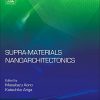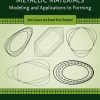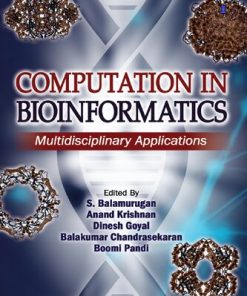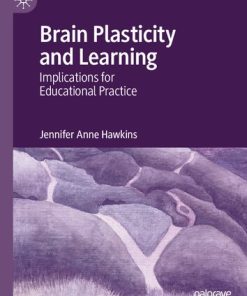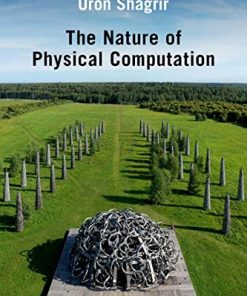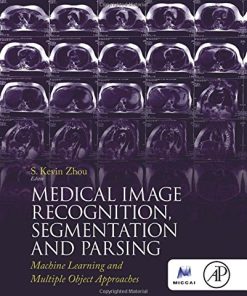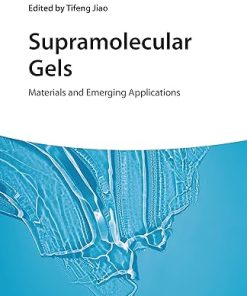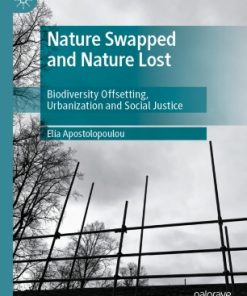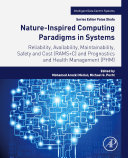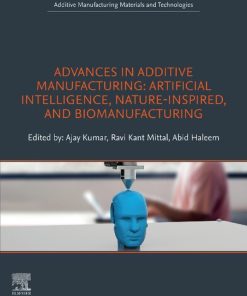(EBOOK PDF)Brain and Nature Inspired Learning Computation and Recognition 1st edition by Licheng Jiao 9780128204047 0128204044 full chapters
$50.00 Original price was: $50.00.$25.00Current price is: $25.00.
Brain and Nature-Inspired Learning, Computation and Recognition 1st edition by Licheng Jiao – Ebook PDF Instant Download/Delivery: 9780128204047, 0128204044
Full download Brain and Nature-Inspired Learning, Computation and Recognition 1st edition after payment
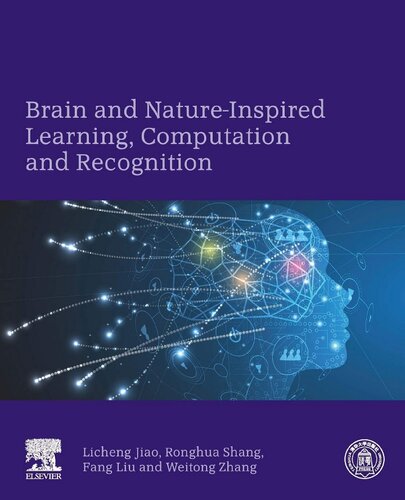
Product details:
• ISBN 10:0128204044
• ISBN 13:9780128204047
• Author:Licheng Jiao
Brain and Nature-Inspired Learning, Computation and Recognition
Brain and Nature-Inspired Learning, Computation and Recognition presents a systematic analysis of neural networks, natural computing, machine learning and compression, algorithms and applications inspired by the brain and biological mechanisms found in nature. Sections cover new developments and main applications, algorithms and simulations. Developments in brain and nature-inspired learning have promoted interest in image processing, clustering problems, change detection, control theory and other disciplines. The book discusses the main problems and applications pertaining to bio-inspired computation and recognition, introducing algorithm implementation, model simulation, and practical application of parameter setting.
Readers will find solutions to problems in computation and recognition, particularly neural networks, natural computing, machine learning and compressed sensing. This volume offers a comprehensive and well-structured introduction to brain and nature-inspired learning, computation, and recognition.
Presents an invaluable systematic introduction to brain and nature-inspired learning, computation and recognition
Describes the biological mechanisms, mathematical analyses and scientific principles behind brain and nature-inspired learning, calculation and recognition
Systematically analyzes neural networks, natural computing, machine learning and compression, algorithms and applications inspired by the brain and biological mechanisms found in nature
Discusses the theory and application of algorithms and neural networks, natural computing, machine learning and compression perception
Brain and Nature-Inspired Learning, Computation and Recognition 1st Table of contents:
Cover image
Title page
Table of Contents
Copyright
Chapter 1. Introduction
1.1. A brief introduction to the neural network
1.2. Natural inspired computation
1.3. Machine learning
1.4. Compressive sensing learning
1.5. Applications
Chapter 2. The models and structure of neural networks
2.1. Ridgelet neural network
2.2. Contourlet neural network
2.3. Convolutional neural network
2.4. Recurrent artificial neural network
2.5. Generative adversarial nets
2.6. Autoencoder
2.7. Restricted Boltzmann machine and deep belief network
Chapter 3. Theoretical basis of natural computation
3.1. Evolutionary algorithms
3.2. Artificial immune system
3.3. Multiobjective optimization
Chapter 4. Theoretical basis of machine learning
4.1. Dimensionality reduction
4.2. Sparseness and low rank
4.3. Semisupervised learning and kernel learning
Chapter 5. Theoretical basis of compressive sensing
5.1. Sparse representation
5.2. Compressed observation
5.3. Sparse reconstruction
Chapter 6. Multiobjective evolutionary algorithm (MOEA)-based sparse clustering
6.1. Introduction
6.2. Modified function and feasible-guiding strategy-based constrained MOPs
6.3. Learning simultaneous adaptive clustering and classification learning via MOEA
6.4. A sparse spectral clustering framework via MOEA
6.5. Experiments
6.6. Summary
Chapter 7. MOEA-based community detection
7.1. Introduction
7.2. Multiobjective community detection based on affinity propagation
7.3. Multiobjective community detection based on similarity matrix
7.4. Experiments
7.5. Summary
Chapter 8. Evolutionary computation-based multiobjective capacitated arc routing optimizations
8.1. Introduction
8.2. Multipopulation cooperative coevolutionary algorithm
8.3. Immune clonal algorithm via directed evolution
8.4. Improved memetic algorithm via route distance grouping
8.5. Experiments
8.6. Summary
Chapter 9. Multiobjective optimization algorithm-based image segmentation
9.1. Introduction
9.2. Multiobjective evolutionary fuzzy clustering with MOEA/D
9.3. Multiobjective immune algorithm for SAR image segmentation
9.4. Experiments
9.5. Summary
Chapter 10. Graph-regularized feature selection based on spectral learning and subspace learning
10.1. Nonnegative spectral learning and subspace learning-based graph-regularized feature selection
10.2. Experiments of spectral learning and subspace learning methods for feature selection
Chapter 11. Semisupervised learning based on nuclear norm regularization
11.1. Framework of semisupervised learning (SSL) with nuclear norm regularization
11.2. Experiments and analysis
Chapter 12. Fast clustering methods based on learning spectral embedding
12.1. Learning spectral embedding for semisupervised clustering
12.2. Fast semisupervised clustering with enhanced spectral embedding
Chapter 13. Fast clustering methods based on affinity propagation and density weighting
13.1. The framework of fast clustering methods based on affinity propagation and density weighting
13.2. Experiments and analysis
Chapter 14. SAR image processing based on similarity measures and discriminant feature learning
14.1. SAR image retrieval based on similarity measures
14.2. SAR image change detection based on spatial coding and similarity
Chapter 15. Hyperspectral image processing based on sparse learning and sparse graph
15.1. Hyperspectral image denoising based on hierarchical sparse learning
15.2. Hyperspectral image restoration based on hierarchical sparse Bayesian learning
15.3. Hyperspectral image dimensionality reduction using a sparse graph
Chapter 16. Nonconvex compressed sensing framework based on block strategy and overcomplete dictionary
16.1. Introduction
16.2. The block compressed sensing framework based on the overcomplete dictionary
16.3. Image sparse representation based on the ridgelet overcomplete dictionary
16.4. Structured reconstruction model
16.5. Nonconvex reconstruction strategy
Chapter 17. Sparse representation combined with fuzzy C-means (FCM) in compressed sensing
17.1. Basic introduction to fuzzy C-means (FCM) and sparse representation (SR)
17.2. Two versions combining FCM with SR
17.3. Experimental results
17.4. SAR images
Chapter 18. Compressed sensing by collaborative reconstruction
18.1. Introduction
18.2. Methods
18.3. Experiment
Chapter 19. Hyperspectral image classification based on spectral information divergence and sparse representation
19.1. The research status and challenges of hyperspectral image classification
19.2. Motivation
19.3. Spectral information divergence (SID)
19.4. Sparse representation classification method based on SID
19.5. Joint sparse representation classification method based on SID
19.6. Experimental results and analysis
Chapter 20. Neural network-based synthetic aperture radar image processing
20.1. Discriminant deep belief network for SAR image classification
20.2. Convolutional-wavelet neural network for SAR image segmentation
20.3. Deep neural network for SAR image registration
Chapter 21. Neural networks-based polarimetric SAR image classification
21.1. PolSAR decomposition
21.2. Autoencoder for PolSAR image classification
21.3. DBN for PolSAR image classification
21.4. Wishart deep stacking networks for PolSAR image classification
Chapter 22. Deep neural network models for hyperspectral images
22.1. Deep fully convolutional network
22.2. Recursive autoencoders
22.3. Superpixel-based multiple local CNN
Index
Read More
People also search for Brain and Nature-Inspired Learning, Computation and Recognition 1st:
brain and nature-inspired learning, computation
brain and nature inspired learning computation and recognition
nature learning process
what is nature based learning
what is brain based learning theory
Tags:
Brain and Nature,Computation and Recognition,Licheng Jiao
You may also like…
Education Studies & Teaching - School Education & Teaching
Computers - Computer Science
Engineering
Business & Economics - Mathematical Economics
Portfolio Optimization with Different Information Flow 1st Edition
Computers - Applications & Software
Biography & Autobiography - Entertainment Biography


